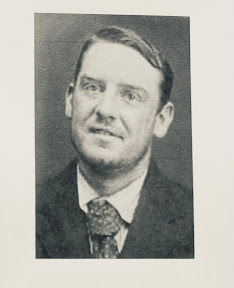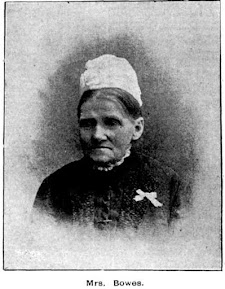Murder by Jealousy!
I have mentioned previously that famous, extraordinary, ordinary and the infamous all lie in harmony in Rookwood. To date I have made mention of the extraordinary. Today's blog is about a person who became infamous.
STUART WILSON CHRISTOPHER BRIGGS
Stuart was born in June 1874, the youngest of William and Sarah Briggs' children. By 1898 he had worked as a Storeman as well as a probationary Police Constable. He had been dismissed from the Police Force in 1893 after only four months in the job. Briggs was over 6' tall with a large build and known to succumb to violent rages particularly whilst drinking.
Stuart Wilson Christopher Briggs - from Captured -NSW State Archives
In the mid to late 1890's a severe recession took grip of the country with many people leaving the regions and converging on the cities, in turn making employment harder to gain for everyone. Briggs found himself unemployed in 1898.
Although unemployed, Briggs was "stepping out" with Maggie Binud Dutt, originally from Glasgow, Scotland, since early in the year. Maggie lived with her grandmother, Margaret Miller, and her younger sister, Kimini, in Petersham. Both her parents had died some years prior.
On 11 December 1898, Briggs visited Dutt and accused her of seeing another man. He became so enraged he struck her, knocking one of her teeth out. According to reports at the time, Briggs allegedly deposited his revolver at a gunsmith for repair and purchased cartridges the following day.
A few days later on 14th December, Briggs went to Dutt's home and demanded of Maggie's grandmother to see her. Margaret stood firm but Maggie descended the stairs to talk to him. In an instant, he shot Maggie twice in the head and then turned and shot Margaret in the head at almost point-blank range. Kimini, the only other occupant of the house at the time, heard the gunshots, ran to the balcony and saw Briggs running off. She tore downstairs to find both her sister and her grandmother dead. She ran to Petersham Police Station to alert the authorities.
Meanwhile, Briggs had run to the Johnson Street wharf in Annandale after disposing of the revolver along the way. He took a leap into the cold water in an effort to drown himself but didn't succeed. A private detective, Robert Nelson Swinburne, on duty at the wharf, helped him out and Briggs confessed to his crime asking what he should do. Swinburne told Briggs to surrender to the Police and escorted him to Balmain Police Station. He revealed to Swinburne that he had also tried to shoot himself after the murders but couldn't do it and throw the revolver away.
Briggs confessed that he had shot his "sweetheart" in a fit of jealousy as he believed she no longer loved him, and he murdered Margaret for interfering in their relationship. Even with a detailed confession, he pleaded not guilty on the grounds of insanity.
At the Supreme Court on 17 February 1899, in front of Judge Henry Emmanuel Cohen, Briggs pleaded not guilty to murder but his plea was discarded, and he was sentenced to death by hanging. Briggs was taken to Darlinghurst Gaol where he spent the time until his execution day in a solitary cell. He spent his time contemplating his actions and turning to prayer to get him through the long days. A petition for clemency which attracted over 2,000 signatures was handed down; but was ignored.
The man who committed murder, tried to shoot himself and then drown was hanged on 5th April 1899; his executioner, Robert "Nosey Bob" Howard (who had brought about the demise of many Rookwood inhabitants) was the man tasked to see him off to his maker.
Maggie Dutt and her grandmother, Margaret Miller, were buried together in the old Presbyterian section of Rookwood cemetery. After his execution, Briggs was buried in the same section of the cemetery with other family members, only a few plots away.
Briggs Headstone - author's own
Maggie Dutt's headstone (also Margaret Miller) - author's own
Kimini Dutt, remained a single woman, died in 1925 and is buried in a section near to her sister and grandmother.
Kimini Dutt's headstone - Find-a-grave with thanks
Judge Henry Emmanuel Cohen, a fair and just man although insisting on the letter of the law in procedures, continued as a Judge on the Supreme Court. After the Industrial Arbitration Act was passed in 1901, he became the first President of the Arbitration Court in April 1902 and served in that role until 1905. After he returned to the Supreme Court. In early 1911 he left for a holiday in England and suffered a fatal heart attack in January 1912, his body was returned to Sydney and buried in the Jewish area of Rookwood.
Henry Emanuel Cohen headstone - Rookwood General Cemetery with thanks
"Nosey Bob" remained the NSW hangman until his retirement in 1904. He died in 1906 and is buried at Waverley Cemetery.
The NSW State Archives have a great archive of information contained in their exhibition "Captivated" information can be seen at the following site
Finally, I wish to acknowledge the contents of the book "An Uncommon Hangman" by Rachel Franks which details the life and the death(s) of Robert "Nosey Bob" Howard - a fabulous read.
Any comments can be placed below or on the group Facebook page under
rookwoodcemeterydiscoveries
Failing that just send me an email at
lorainepunch@gmail.com








Comments
Post a Comment